Old states of Germany
The old states of Germany (German: die alten Bundesländer) are the 10 states in West Germany.
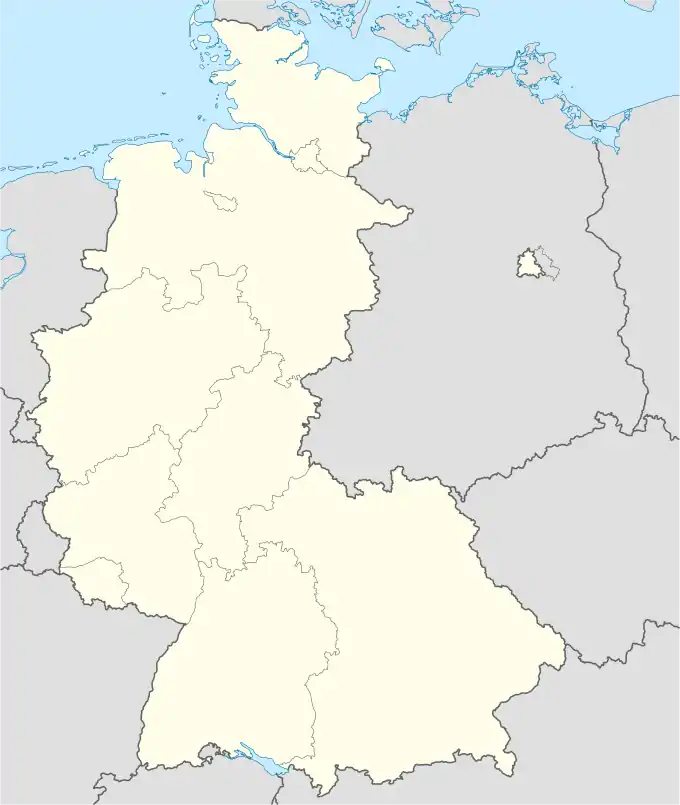
Part of a series on the |
||||||||||
|---|---|---|---|---|---|---|---|---|---|---|
| History of Germany | ||||||||||
 | ||||||||||
| Topics | ||||||||||
| Early history | ||||||||||
| Middle Ages | ||||||||||
| Early Modern period | ||||||||||
| Unification | ||||||||||
| German Reich | ||||||||||
|
||||||||||
| Contemporary Germany | ||||||||||
|
||||||||||
|
| ||||||||||
Since the reunification, Germany thus consists of 16 states with equal legal statuses. Yet the process of the "inner reunification" between the former Eastern and Western Germany is still ongoing. The Old States are:
- Baden-Württemberg
- Bavaria
- Bremen
- Hamburg
- Hesse
- Lower Saxony
- North Rhine-Westphalia
- Rhineland-Palatinate
- Saarland
- Schleswig-Holstein
Whether West Berlin is considered an "old state" depends on the context, since it was closely associated with the Federal Republic of Germany, but its status was disputed because of the Four Power Agreement on Berlin.
The old states are colloquially referred to as Former West Germany, although the name West Germany has additional meanings.
Religion
Religion in West Germany with West Berlin (2016)[1]
Christianity is the dominant religion of Western Germany, excluding Hamburg, which has a non-religious plurality. On the other hand, Irreligion is predominant in the Eastern part of Germany, considered to be the least religious region in the world.[2][3][4] An exception is former West Berlin, that had a Christian plurality in 2016 (44.4% Christian and 43.5% Unaffiliated). It also has a higher share of Muslims, or 8.5%, compared to former East Berlin, with only 1.5% self-declared Muslims as of 2016.[1]
| Religion by state, 2016[1] | Protestants | Catholics | Not religious | Muslims | Others |
|---|---|---|---|---|---|
| 37.6% | 40.6% | 16.4% | 2.5% | 3.0% | |
| 23.4% | 58.6% | 15.6% | 1.1% | 1.3% | |
| 51.8% | 7.8% | 39.1% | 0.0% | 1.3% | |
| 32.0% | 12.4% | 43.5% | 8.5% | 3.5% | |
| 34.3% | 9.0% | 44.1% | 10.9% | 1.7% | |
| 50.2% | 21.7% | 22.2% | 3.8% | 2.1% | |
| 53.8% | 18.7% | 24.1% | 2.5% | 0.9% | |
| 30.9% | 44.6% | 18.1% | 4.4% | 2.0% | |
| 34.8% | 42.4% | 19.6% | 1.0% | 2.1% | |
| 22.3% | 68.1% | 8.2% | 1.4% | 0.0% | |
| 61.5% | 3.2% | 31.3% | 2.2% | 1.7% | |
| Total | 36.7% | 38.2% | 20.3% | 3.0% | 1.9% |
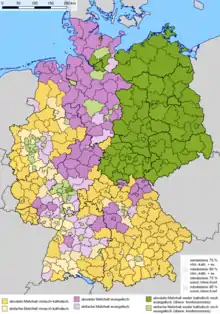 Most West Germans are Christians (2011).
Most West Germans are Christians (2011).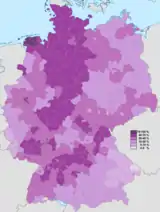 Evangelical population according to the 2011 census
Evangelical population according to the 2011 census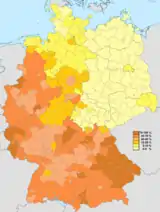 Catholic population according to the 2011 census
Catholic population according to the 2011 census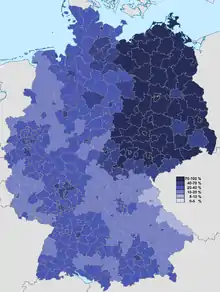 Non-religious population according to the 2011 census (including other religions and not specified)
Non-religious population according to the 2011 census (including other religions and not specified)
Pro Reli

In the referendum on the introduction of the elective area of ethics/religion, where the dominant in West Berlin CDU and FDP to Yes against the Greens (with the exception of their "working group Christians")[5] and SPD[6] have called No, have in West Berlin 58.58% for the Introduction of religious education. (in East Berlin, a total of 74.62% voted no).
Economy
The standard of living and annual income remains significantly higher in the old federal states.[7] In West Germany, there is more income than in the East.[8]
In West Germany, there are smaller farms than in the east.[8]
In the West there are fewer unemployed than in the former East Germany.[9][10]
 The socio-demographic development of Germany after reunification
The socio-demographic development of Germany after reunification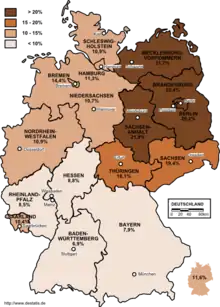
 Nominal GDP per capita, 2015 Eurostat
Nominal GDP per capita, 2015 Eurostat
Politics

In the West and West Berlin[11] the Union, SPD, FDP and Greens stronger, on the other hand right-wing populist parties and The Left weaker than in the east.[12][13]
Unlike in the East, there are not 3 or since 2016 4 equally strong parties but a "two-party dominance" of the SPD and CDU.[14]
A study of the University of Berlin from 1998/99 comes to 13% for the whole of Germany, and 12% for the West and 17% for the East for right-wing extremist recruitment potential.[15] In the 2017 Federal Election, AfD reached ~ 22%[16] in the East and ~ 11%[17] in the West.[18]
There are also higher voter turnouts in the West.[14]
 Social Democrats (SPD)
Social Democrats (SPD) Free Democrats (FDP)
Free Democrats (FDP) The Greens
The Greens Christian Democrats (CDU/CSU)
Christian Democrats (CDU/CSU)
Demographic development
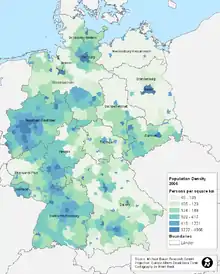
In the old states the average age is lower than in the east.[8]
Demographic evolution
In the old federal states, the populations also developed differently. In Baden-Württemberg, Bavaria, Hamburg, Hesse and Schleswig-Holstein, the population increased steadily. In Saarland, on the other hand, the population dropped steadily. The population of North Rhine-Westphalia (until 2004), Lower Saxony and Rhineland-Palatinate (both until 2003) initially increased and then fell off again. The population of Bremen dropped until the year 2001, then rose to the year 2007 and began to fall again in 2008.
Since 1980, birth rates have been relatively constant.[8]
Migration
There are more migrants in West Germany than in the East.[19][20][21]
 There are far fewer migrants in the East than in the West, according to the results of the 2011 Census at district level.
There are far fewer migrants in the East than in the West, according to the results of the 2011 Census at district level. In most western counties, Turks are the largest foreign population.
In most western counties, Turks are the largest foreign population.


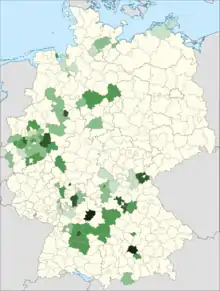
 Portuguese
Portuguese
 Dutch
Dutch
 Austrians
Austrians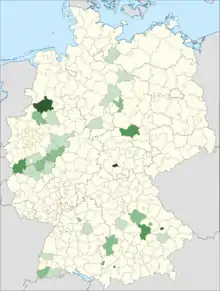
 French
French
See also
References
- "Konfession, Bundesland - weighted (Kumulierter Datensatz)". Politbarometer 2016: Question V312.F1. 2016 – via GESIS.
- "Ostdeutschland: Wo der Atheist zu Hause ist". Focus. 2012. Retrieved 2017-11-11.
- "WHY EASTERN GERMANY IS THE MOST GODLESS PLACE ON EARTH". Die Welt. 2012. Archived from the original on 2013-02-18. Retrieved 2009-05-24.
- "East Germany the "most atheistic" of any region". Dialog International. 2012. Retrieved 2009-05-24.
- Grüne Christen unterstützen „Pro Reli“. In: Der Tagesspiegel, 27. März 2009.
- Argumente zum Ethikunterricht SPD-Berlin Oktober 2008 (PDF; 99 kB)
- "The Price of a Failed Reunification". Spiegel International. 2005-09-05. Retrieved 2006-11-28.
- http://www.zeit.de/feature/mauerfall-das-geteilte-land
- http://www.zeit.de/wirtschaft/2014-10/arbeitslosigkeit-osten
- https://statistik.arbeitsagentur.de/Navigation/Statistik/Statistik-nach-Regionen/Politische-Gebietsstruktur/Ost-West-Nav.html
- "Archived copy". Archived from the original on 2018-08-24. Retrieved 2017-11-12.CS1 maint: archived copy as title (link)
- https://www.wiwo.de/politik/deutschland/bundestagswahl-osten-waehlt-immer-noch-anders-als-der-westen/8789876.html
- https://www.destatis.de/DE/ZahlenFakten/ImFokus/Sonstiges/DeutscheEinheitWahlverhaltenOstWest.html
- https://www.bpb.de/geschichte/zeitgeschichte/deutschlandarchiv/202315/parteien-und-parteienwettbewerb-in-west-und-ostdeutschland
- Nach Iris Huth: Politische Verdrossenheit, Band 3, 2004, S. 226.
- https://www.wahlen-in-deutschland.de/buBundOst.htm
- https://www.wahlen-in-deutschland.de/buBundWest.htm
- "Bundestagswahl 2017".
- http://katapult-magazin.de/de/artikel/artikel/fulltext/die-rechten-ziehen-in-den-osten-auslaender-in-den-westen/
- https://www.bpb.de/nachschlagen/zahlen-und-fakten/soziale-situation-in-deutschland/61625/auslaendische-bevoelkerung-nach-laendern
- http://www.laenderdaten.de/europa/deutschland/bundeslaender/auslaenderanteil.aspx